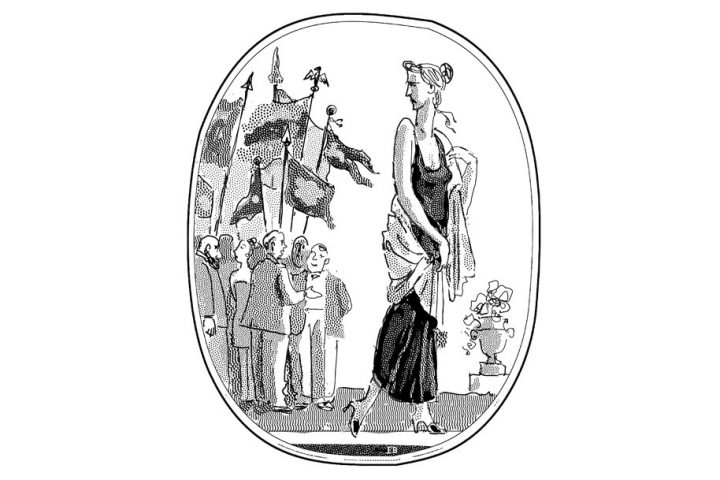In contradiction of Lincoln’s second inaugural, the watchwords of the revolution of 2020—and it is a revolution—might well be, “With malice toward all, and charity for miscreants.” Stealing a march on the forced self-denunciations of China’s Cultural Revolution, Americans now willingly, sincerely self-denounce with weird passion. Take for example a white officer writing in the Navy’s chief professional journal: “Most white naval officers are not consciously racist,” but, he says, quoting James Baldwin, “‘It is the innocence which constitutes the crime.’” Stalin, Beria, and Lewis Carroll take note.
In the same issue, another writer proposes that:
The Navy should partner with a racial justice organization that can provide an independent review of Navy policies…. Create and fund the role of a (non-white) Race Advisor to assist all upper echelon commands…. [And] partner with a Black/Indigenous/POC-led racial justice organization to conduct training.
And you thought that only in the USSR, China, and Tom Clancy novels did political officers go to sea.
Madness such as this is the muck through which ideological piles are driven as the foundation for oppression. To continue with metaphors, consider the following: We understand time analogously as movement through space. Whereas an analog clock expresses this physically, it does so with numbers as well, and a digital clock solely with numbers, which in turn have no meaning unless reconverted to the analog conception of movement through space. In that sense—just as, in battle, strategy depends upon spatial understanding—the workings of the current revolutionary/counter-revolutionary dynamic may be illuminated by spatial and metaphorical analogies.
For example, a standard concept in real-estate investment is that future development will occur on the shortest line between two prosperous centers of population—strongpoints, if you will—within easy reach of one another. The increasingly hard Left has taken over the strongpoints of American life—educational systems, the press, entertainment, sports, a large slice of religion, institutions of high culture, foundations, most professional organizations, and pusillanimous businesses, from sneaker manufacturers to banking behemoths. Now, even one of the two major political parties is a hostage deep in the throes of Stockholm Syndrome.
Though paradoxically composed mainly of idiots, Antifa itself is a brilliant strongpoint. Its flying squads concentrate and dominate where required. Baby terrorists and guerillas (for the moment), its Brownshirts have outsized effect, much as in the longstanding Communist tactic of salting a large meeting with a few supporters evenly spread throughout a room, who to swing things their way pipe up simultaneously as if in far greater number and representation. Just as a board fence is no match for a 2,500-pound bull (but he doesn’t know that), illusory or collapsible strongpoints can yet succeed if they merely appear unassailable. The Portland police could put an end to Antifa in an evening, but the city government (i.e., the dull mind of the bull) dictates otherwise.
As in the real-estate analogy, the areas between the strongpoints are beginning to thicken. What is added to them, like grass in its tender multitudes, is people, because people naturally gravitate to structure and lines of strength. If allowed to proceed, this filling-out of the empty spaces, the penultimate stage of revolutionary development, becomes irreversible other than by sclerotic death after decades of Jacobin repression.
* * *
The strongpoints are occupied and immediately out of reach. Given the past half-century of indoctrination, reinforcement, and now the purification phase, they are almost impossible to assail. And long before they collapse of their own weight they will have had ample opportunity to knit themselves together.
That they have not yet completed their linkages and consolidation should direct the eye to the delicate but immense fabric that lies between them. As with a tarpaulin, the Left’s vulnerability lies not in the grommets but in a break in the weave, its weak point, because the suffocating enclosure of revolutionary control depends upon the acquiescence of vast numbers of individuals, families, communities, and organizations. And we have yet to enter a state in which Americans can be successfully monitored, punished, or oppressed should they reject individually but en masse the Marxist-utopian reconstruction of America.
Quite apart from matters of policy and traditional politics, the only means to defeat the revolution of 2020 is to bypass opposition strongpoints and go rather to the general public, the fabric of the nation, in a simple, direct, mass appeal to refuse indoctrination, the miserly definition of its history, its villainization, and the characterizations, hectoring, threats, and commands of its self-appointed betters.
At this stage it is still possible to block the strongpoints from connecting, if they can be made to drown in a sea of individual refusals that are fully capable of ripping apart the fabric of revolution until it snaps wildly in the wind.
“No”is one of the most difficult yet liberating words in any language. Though it often comes at a steep price—of peace, tranquility, livelihood, and even life—it is the master key to independence and freedom. Were every American made aware of this inherent power, we would then see how much courage and character we have left. For the simplest declaration is the most potent, and sometimes it moves like wildfire.
How difficult would it be to say, when the demand comes, when the threat comes, when the command comes: No, I do not agree with your redefinitions. No, I will not do as you tell me. No, I will not say what you order me to say. No, I will not surrender my freedom of speech and expression. No, I will not accept your revolution. And I will not stand against my country.



